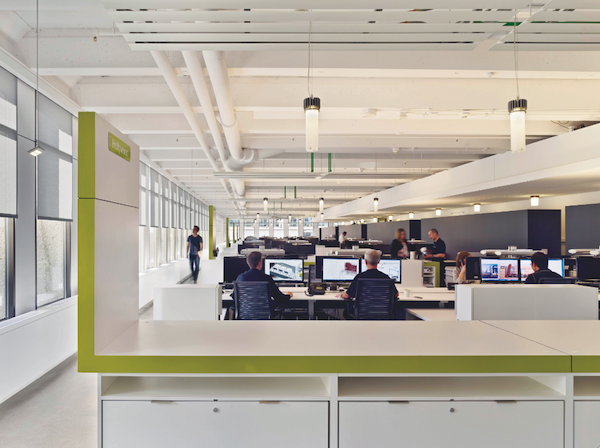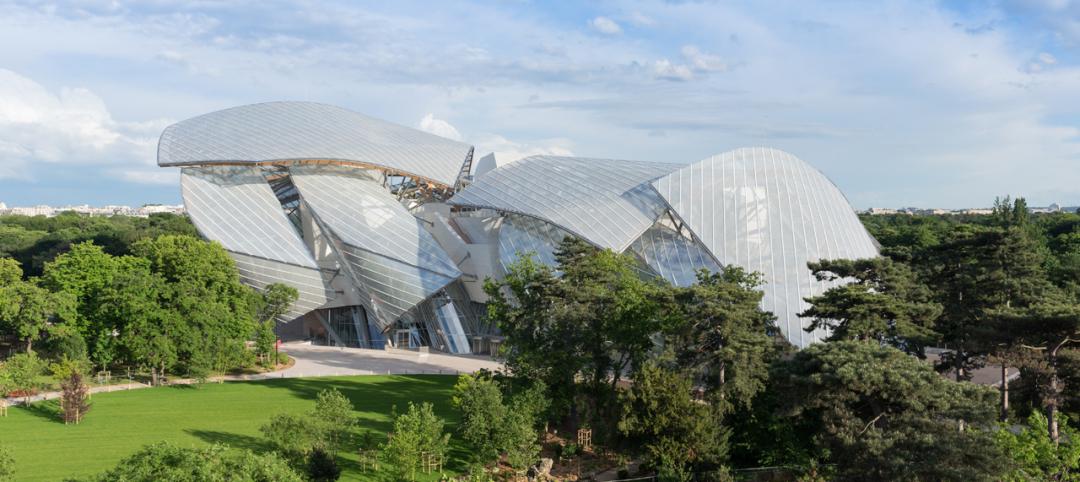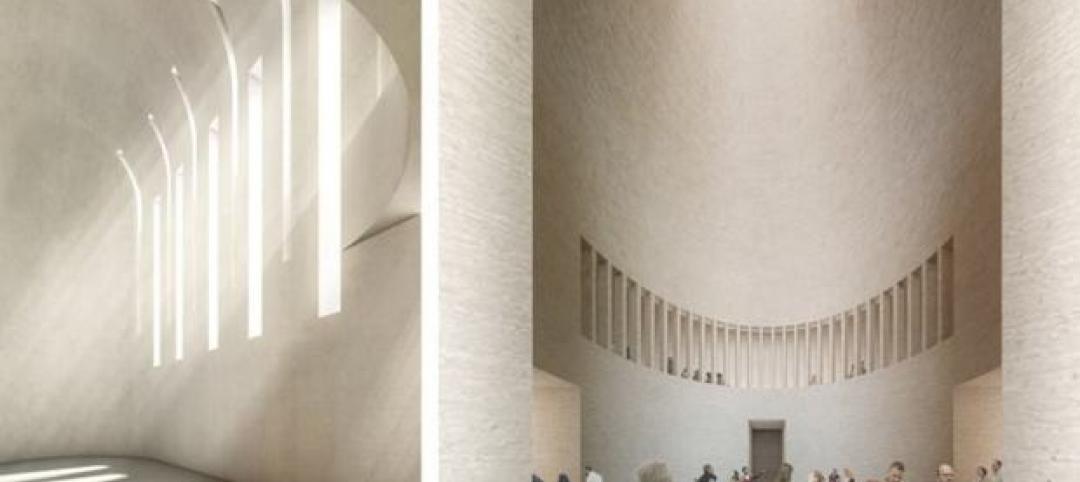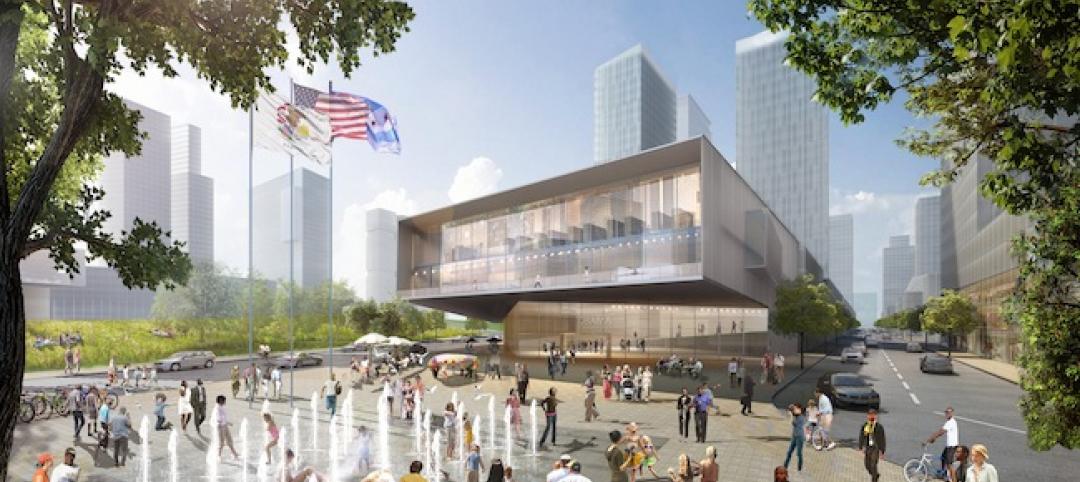Windows not only transform the façade of a building, the natural light that they allow inside is a vital tool in highlighting a building’s interior design elements.
But sunlight is not always needed—or even wanted. At some point in the day, direct sunlight will enter the space, causing glare and heat gain.
Enter the interior shade system.
“The primary purpose of a shade system is to control glare for the user’s visual comfort,” says Kristopher Baker, PE, LEED AP, Senior Associate in the Denver office of Syska Hennessy Group. These systems also help eliminate excess heat caused by direct sunlight.
Designing a shade system is more complex than picking out basic white venetian blinds. The Building Team’s overall design and functional goals should be considered, as well as the end user’s needs. Here are five elements to consider when designing an interior shade system.
1. Make sure the type of shade system meets client needs and program goals.
The type of device should be chosen based on the client’s needs and the overall programmatic goals of the project. Different types of shades have different benefits, according to Baker.
• Honeycomb shades feature two to three layers that trap air inside, acting as insulation and allowing users to reduce heat loss through the windows.
• Venetian blinds are available in various sizes with slats that can be tilted at different angles to control the amount and direction of sunlight that is allowed into a space.
• Roller shades are panels of fabric with varying levels of openness in the weave.
Follow these guidelines to get your shade system right
1. Make sure the type of shade system meets client needs and program goals.
2. Fit the shade system to the specific type
of space you’re working in.
3. Check out the new control mechanisms
that are available.
4. Use shades to help meet your project’s
energy goals.
5. Look into the future of shading technology.
Joseph Parks, national sales manager for commercial window treatments at Lutron, says a shade should be chosen primarily for its function, rather than its form. “A lot of times the fabric is chosen based on the look or the aesthetic or how it matches the interior, rather than how transparent the fabric is with regard to light,” he says.
2. Fit the shade system to the specific type of space you’re working in.
Baker highlights the importance of understanding the space and what it will be used for when designing a shade system. Shades are used to control glare in a specific environment, but not all spaces need shades. For example, an airport terminal is one location where shading devices are not necessarily desirable.
“Having direct sun and having that brightness helps you with your circadian rhythms, and that’s what helps you get over jet lag,” Baker says. “That’s why most of the new airports have a lot of daylight coming into the space.”
However, for an eye clinic, where patients are moving throughout the facility with their pupils dilated, a shade system would be ideal for reducing the amount of direct sunlight penetrating the space.
High-traffic areas such as atriums and lobbies require a more varied approach in shade design, with a number of options for glare control.
The library of Calvert High School in Prince Frederick, Md., is one such location where a shade system was necessary for the productivity and comfort of the occupants. Skylight panels totaling 17,000 sf top the media center, but the possibility of disruptive glare and heat gain posed a challenge. A user-controlled mechanical shade system allows school administrators to control the position of the shades for the comfort of students and staff working below.
3. Check out the new control mechanisms that are available.
The use of automated control systems is on the rise, according to Parks. “There’s certainly a big trend in the solar tracking arena of shades,” he says. “The shades are smart enough to understand where the sun is supposed to be in relation to the building, so they can either manage the daylight or allow more daylight into the space.”
More advanced technology places sensors on the window, allowing for more precise automatic glare control based on the sun’s position.
The Portland, Ore., office of engineering firm Glumac features one such automated system. Solar-adaptive roller shades automatically adjust based on the amount of direct sunlight entering the space.
Manual systems have their merits, but Baker warns that building users can override the shading system. “If you walk around an office park, you’ll see that 80 to 85% of the blinds of every office are closed so that people can’t see out,” he says. “People have no problem getting rid of sun when they’re annoyed by it, but when the sun goes away they don’t open them back up.”
If a manual system is specified, user education is vital to ensure building occupants operate the shading system the way the Building Team and owner intended.
4. Use shades to help meet your project’s energy goals.
Shades can lower a building’s HVAC cooling load by about 10% and can increase the daylight harvesting savings by 30–40%, according to Parks. Care must be taken to determine what the building’s overall energy goals will be and how the shade system will fit into that plan.
At the Glumac office, the solar-controlled shades are accompanied by a lighting system with vacancy and daylight sensors that work together to adjust the amount of natural and artificial light in the space, with an ultimate goal of reducing the building’s dependence on electric lighting.
While shade systems are a part of an effective daylighting strategy, Baker stresses that some form of glare control should be implemented in the design of any building, regardless of its daylighting techniques.
“You can’t allow the direct sun to come in and splash your desk,” he says. “Fundamentally, the glare control has to be part of a solution, whether there’s daylighting or not.”
5. Look into the future of shading technology.
What is innovative right now might be outdated and less efficient than newer technologies in 10 years. An investment in new technology might prove more efficient and effective than relying on what you’ve always used.
“The technologies are going to continue to get smarter,” says Parks. “We’ve gone pretty far in that we can now sense what is going on right outside the window, but you may see systems that can communicate to building management systems and develop a hierarchy of needs based on temperature and light, rather than just light.”
Baker sees that innovation being taken one step further, with the expansion of dynamic glass technology that may eliminate the need for a shade system altogether.
Electrochromic glass uses an electrical pulse to control the tint of the glass; thermochromic glass changes the tint based on the surface’s temperature.
“If the sun is on that glass, then it goes dark; if the sun is not on that glass, it stays clear,” Baker says. “It’s expensive technology right now, but if they get a hold in the marketplace, you will not need interior blinds.”
Related Stories
| Jun 23, 2014
Gehry's 'glass sail' cultural center for Foundation Louis Vuitton set to open in October
Comissioned by Bernard Arnault, American legendary architect Frank Gehry's newest structure in Paris for Foundation Louis Vuitton will house eleven galleries and an auditorium for performing arts.
| Jun 23, 2014
Power of IPD: Is integrated project delivery truly a transformative delivery model?
Now that many of the first-generation IPD projects have been completed, CBRE Healthcare's Tim McCurley and Stephen Powell ponder the lessons learned and pros and cons of the industry's newest delivery model.
| Jun 23, 2014
Lilker Associates launches Lighting Group; David Cyr announced as Director
New division rounds out building systems services offerings for the Manhattan-based consulting firm.
| Jun 23, 2014
Berlin House of One will accommodate Muslims, Jews, and Christians
The building will rise on the ruins of a 13th-century Christian church that was damaged during WWII and eventually demolished.
| Jun 22, 2014
5 ways to improve your firm’s branding efforts
Establishing, conveying, and maintaining a powerful brand is a critical component of an AEC firm’s marketing strategy. Here are five strategies to make a greater impact with your firm’s branding efforts.
Sponsored | | Jun 22, 2014
JW Marriott Indianapolis redefines city’s skyline
The 34-story JW Marriott is both the largest and tallest hotel in Indianapolis. One of the most prestigious hotels in the city, the JW Marriott has hosted celebrities and NFL teams alike.
| Jun 20, 2014
HOK releases proposal for Obama Library and Museum Campus
Proposal would locate the library in Chicago's historic Bronzeville neighborhood, aiming for urban revitalization as well as Living Building certification.
| Jun 20, 2014
Sterling Bay pulled on board for Chicago Old Main Post Office project
Sterling Bay Cos. and Bill Davies' International Property Developers North America partner up for a $500 million restoration of Chicago's Old Main Post Office
| Jun 20, 2014
First look: Hive-like 'Learning Hub' to be built in Singapore
In a competition to design a "Learning Hub" for students at Nanyang University in Singapore, London-based firm Heatherwick studio has won with a rounded, hive-like design.
| Jun 20, 2014
U.S. Energy Information Administration releases preliminary Commercial Buildings Energy Consumption Survey results
Federal survey project shows that commercial-building floorspace has grown 22% since 2003; energy-use data will be released in Spring 2015.















